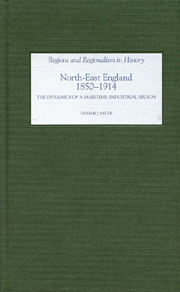Book contents
- Frontmatter
- Contents
- Dedication
- List of illustrations
- Preface
- 1 The North East in time and space
- 2 Horizons: ports, trade and mobility
- 3 Hinterlands and industrial districts
- 4 Making and managing the maritime landscape
- 5 Cohesion and diversity in the maritime urban system
- 6 The horizons of North East shipowning
- 7 Business and the maritime-industrial complex
- 8 Conclusion
- Sources and bibliography
- Index
5 - Cohesion and diversity in the maritime urban system
Published online by Cambridge University Press: 12 September 2012
- Frontmatter
- Contents
- Dedication
- List of illustrations
- Preface
- 1 The North East in time and space
- 2 Horizons: ports, trade and mobility
- 3 Hinterlands and industrial districts
- 4 Making and managing the maritime landscape
- 5 Cohesion and diversity in the maritime urban system
- 6 The horizons of North East shipowning
- 7 Business and the maritime-industrial complex
- 8 Conclusion
- Sources and bibliography
- Index
Summary
J. B. Priestley called the Thames ‘London's broadest street’. This provokes a number of thoughts about the relationship between waterways and towns, which go well beyond the constitutional and jurisdictional concerns of town councils introduced in Chapter 4. Having navigable water in the centre of a town has historically offered lucrative long-distance connections but also posed short-distance challenges, and maritime towns have found themselves both liberated and limited as a result. Streets made from water are obviously harder to cross than those made of earth, and the urban spaces on either side of them face difficulties in forming a united whole even when they want to. Over time, in the North East as elsewhere, such circumstances played an important role in moulding and defining the attitudes and character of riverside and waterfront towns. As well as having their own internal lives, individual towns were also the components of increasingly complicated urban systems by the later nineteenth century, and the extent to which those systems represented meaningful district or regional agglomerations is an important indication of the working horizons of the North East.
By the time of the Great War, Tyneside was a nearly continuous built-up area running from Newcastle and Gateshead to the sea via Wallsend, Hebburn, Jarrow, South Shields, North Shields, Tynemouth and a number of smaller places with industrial workforces and urban characteristics. This was by some way the North East's largest urban cluster during this period, a fact well appreciated by those whose business it was to move people around.
- Type
- Chapter
- Information
- North East England, 1850–1914The Dynamics of a Maritime-Industrial Region, pp. 111 - 138Publisher: Boydell & BrewerPrint publication year: 2006



